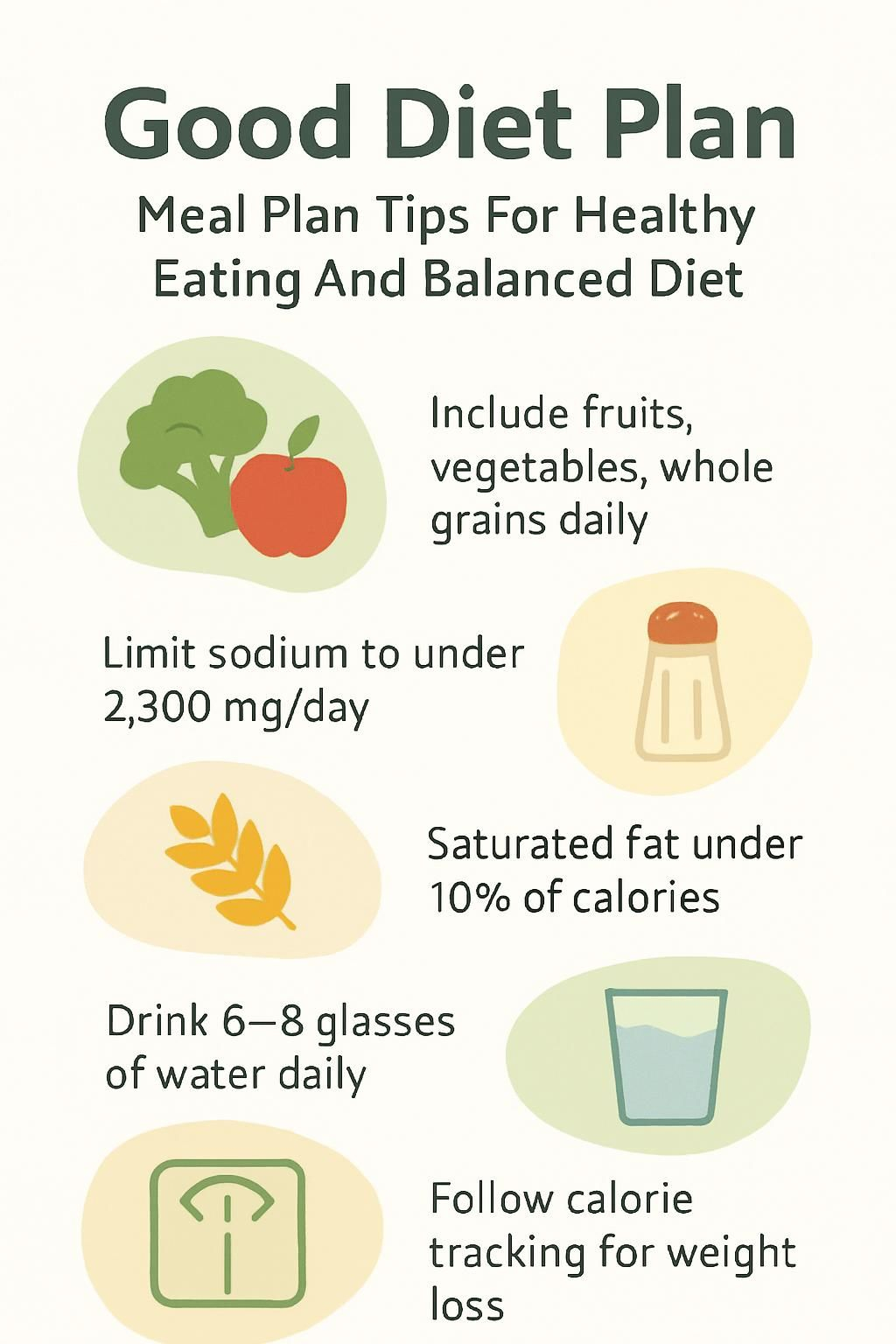Good Diet Plan: Meal Plan Tips For Healthy Eating And Balanced Diet
Our Nutrition Assistant AI Suite will transform your body. You will lose fat, get toned, and build muscle. Gain confidence and optimal health.
Building a good diet plan can feel overwhelming. Clear steps help you turn healthy eating into a simple routine. Research shows that meal plans built on core food groups, like fruits, vegetables, whole grains, protein, and dairy, support a healthy weight and lower the risk of heart disease.
This guide offers practical tips for your eating plan, smarter food choices, and right-size servings. You will see everyday examples you can use right away. This article is educational, not medical advice. Speak with a registered dietitian or your doctor if you have a health condition.
Key Takeaways
- A balanced diet plan highlights fruits, vegetables, whole grains, lean proteins, and low-fat dairy. The DASH and Mediterranean diets link to lower heart disease risk and healthy weight (U.S. News & World Report 2025; NEJM 2013).
- Keep saturated fat under 10 percent of daily calories. Limit added sugars and sodium to under 2,300 mg per day to support weight and blood pressure control (American Heart Association; Harvard T.H. Chan School of Public Health).
- The DASH plan can reduce blood pressure within two weeks by emphasizing low-sodium choices plus fruits, vegetables, and whole grains (NIH; U.S. News & World Report 2025).
- Tools like the Mayo Clinic Healthy Weight Pyramid guide steady, realistic weight loss through balanced portions and daily calorie tracking (Mayo Clinic; NHS 2023).
- Drinking 6 to 8 glasses of water a day and choosing nutrient-rich snacks supports energy, focus, and healthy habits (NHS Eatwell Guide; Mayo Clinic).

Why is a Balanced Diet Important for Health?

Food is your daily fuel. A healthy diet provides the nutrients and energy you need to work, think, and move well. Consistent healthy choices support your goals and your long-term well-being.
How does a balanced diet help maintain overall health?
A balanced diet supports steady energy, a healthy weight, and a strong immune system. You get vitamins, minerals, carbohydrates, protein, healthy fats, and fiber from a mix of foods.
Fruits and vegetables supply vitamin C and potassium. Whole grains add fiber, which helps control blood sugar. Limiting saturated fat and excess sugar reduces risk for obesity and high blood pressure.
I swapped candy for fresh fruit as my afternoon snack. The usual slump disappeared, and my focus improved.
Government nutrition data shows that eating across all food groups, including low-fat dairy, can lower LDL cholesterol and promote healthier patterns in the United States and England.
Can a balanced diet prevent chronic diseases?
Balanced eating supports your body every day, and it also helps prevent long-term disease. The Mediterranean diet is linked to lower risk for cardiovascular disease and type 2 diabetes.
Choosing foods low in saturated fat helps reduce LDL cholesterol and high blood pressure risk. Cutting added sugar and salt helps manage obesity and hypertension. People who follow the DASH diet or MyPlate guidelines have lower heart disease rates in several studies.
Fruits, veggies, whole grains, beans, fish, and unsalted nuts help manage blood sugar and protect heart health. Leafy greens, skinless poultry, brown rice, olive oil, oily fish rich in omega-3s, and low-fat dairy also contribute to lower chronic disease risk.
Reducing red meat that is high in saturated fat and avoiding processed foods high in salt adds more protection. Many people also see safe weight loss while lowering the chance of diabetes or hypertension.
Small choices at breakfast, lunch, dinner, and snack time stack up to big health gains.
Understanding Key Food Groups
Balanced meals draw from different food groups. The right mix helps you meet daily needs and gives you varied, satisfying menus.
What are the benefits of fruits and vegetables?
Aim for at least five portions of fruits and vegetables each day. One portion is 80 grams if fresh, canned, or frozen. Dried fruit counts as 30 grams and is best at mealtime.
Diets rich in produce help reduce heart disease risk and support digestion. Kiwis provide vitamin C, and leafy greens offer potassium to help control blood pressure.
Fruits and vegetables should make up just over one-third of your food each day. A nutrition expert often says, “Eat the rainbow” to cover your nutrient needs.
Fresh produce fills you up with fewer calories than many processed snacks. Studies link this pattern with lower obesity and a lower risk of type 2 diabetes.
Why include starchy foods and whole grains?
After fruits and vegetables, include starchy foods like potatoes, bread, rice, and pasta. These should also make up just over one-third of your daily intake.
Choose higher fiber options such as whole wheat bread or brown rice. Whole grains help control blood sugar and keep you full longer, which can help with weight control.
Swap white bread for whole-grain toast, or use whole wheat pasta instead of refined pasta. I switched to whole-grain toast, and my breakfast kept me satisfied until lunch.
What dairy or dairy alternatives should I choose?
Pick milk and dairy foods that are low in fat and sugar to support heart health. Choose semi-skimmed or skim milk instead of full-fat. Nonfat yogurt offers protein and calcium with little saturated fat or added sugar.
Low-fat cheeses, including cottage cheese, work well in salads, smoothies, or as a snack. If you are lactose intolerant, try soy drinks fortified with calcium. Unsweetened soy drinks deliver similar nutrients without added sugars found in sweetened beverages.
One cup of unsweetened fortified soy drink provides about 300 mg of calcium, similar to cow’s milk. Look for “calcium-fortified” on plant-based options like almond or oat drinks. Choose lower-fat types since frequent full-fat dairy can raise blood cholesterol.
Nonfat yogurt makes a creamy smoothie base or a light coleslaw dressing. I liked mixing nonfat yogurt with fruit or seeds after school, and I still use low-fat cheese slices for a balanced lunch.
Which proteins are best: beans, fish, eggs, or lean meats?
Beans and pulses provide low-fat protein, fiber, and key minerals. Toss kidney beans into salads, or add lentils to soup for a filling meal.
Eat fish at least twice a week, including one serving of oily fish like salmon, sardines, or mackerel. Oily fish supply omega-3 fats that help protect the heart.
Eggs offer high-quality protein and B vitamins. Scrambled eggs on whole-wheat toast make a quick breakfast. Lean meats such as skinless poultry or trimmed pork deliver protein, iron, and zinc with fewer calories than fattier cuts.
Limit red and processed meats, including bacon and sausages. For heart health and disease prevention, rotate your protein sources across the week.
How do healthy fats like oils and spreads fit in?
Vegetable oils and soft spreads provide unsaturated fats that support cell health. Use small amounts of olive, canola, or sunflower oil instead of butter or products with trans fat.
Keeping saturated fat lower, such as from shortening and fatty meats, reduces heart disease risk. Use about one tablespoon of oil per meal for cooking or dressings.
Simple adds like avocado on whole-grain toast, a few nuts on a side salad, or hummus with raw veggies give healthy fats without many extra calories. Choose fat-free or low-fat varieties when you need to reduce total calories while keeping meals satisfying.
How Can I Create a Good Diet Plan?
A good diet plan starts with smart choices and nutrient-dense foods. The steps below help you build balanced meals you can maintain each day.
Why include a variety of food groups?
Variety makes it easier to hit your vitamin and mineral targets. The Eatwell Guide shows that including fruits, vegetables, whole grains like quinoa or brown rice, lean proteins such as fish or beans, and dairy or fortified alternatives supports health and lowers disease risk.
Each group brings something unique. Fiber from starchy foods supports digestion. Dairy can build bone strength. Nuts provide healthy fats, and colorful produce supplies antioxidants that protect your cells.
Mixing foods keeps meals interesting. Try frozen or canned vegetables sautéed in olive oil for quick dinner ideas. A small nut snack between meals can help steady your energy.
Switching between proteins like eggs, beans, or lentils helped me stay full and recover after exercise. This balanced approach supports weight goals without cutting out entire groups.
How does portion control improve your diet?
Portion control works hand in hand with variety. Keeping servings in range helps manage calories and blood sugar. This is especially useful for people with diabetes and for anyone trying to prevent overeating that raises blood pressure.
As a guide, one portion of fruit or vegetables is 80 grams fresh or 30 grams dried at mealtimes. Only 150 milliliters of juice counts as a daily portion because juice has concentrated sugar.
Using smaller plates helped me eat less chocolate and fewer sugary snacks. I did not feel deprived. Studies associate portion awareness with better weight management outcomes^1.
Meal planning tools encourage you to stick to recommended servings, not habits. Drinking a glass of water before meals can also reduce hunger cues.
…
^1 Harvard T.H. Chan School of Public Health: The Nutrition Source – Healthy Eating Plate & Portion Sizes.
What foods should I limit: saturated fats, sugar, and salt?
Many people consume too much saturated fat, sugar, and sodium. Fatty meats, butter, cakes, and pastries contain high saturated fat that can raise cholesterol.
Excess sugar from sweets, sodas, and desserts increases the risk for obesity and tooth decay. Salty snacks and processed foods can push sodium above healthy limits.
Eat these foods less often and in small amounts to support a healthier life. Choosing whole grains over sugary cereals is one simple swap for your good diet plan.
How much water should I drink to stay hydrated?
Most adults need at least 6 to 8 glasses of fluids a day. Water is best, though milk and herbal tea count. Proper hydration supports focus, digestion, and energy, especially during exercise or dieting.
Carry a water bottle as a reminder. Increase fluids during hot weather or heavy activity. I started tracking water in an app and had fewer headaches and better concentration. Clear or pale yellow urine is a sign you are drinking enough.
What Are Popular Diet Plans for Healthy Eating?
Several eating patterns offer clear structure. The DASH, Mediterranean, and Mayo Clinic plans are well studied. Explore which one fits your routine and preferences.
What is the DASH Eating Plan?
DASH stands for Dietary Approaches to Stop Hypertension. It emphasizes fruits, vegetables, whole grains like couscous, lean proteins, and low-fat dairy. Doctors often recommend DASH to help lower high blood pressure because it limits sodium and encourages nutrient-rich foods.
U.S. News & World Report ranked DASH among the best diets for heart health in 2025. There are no special products. You follow simple daily and weekly goals. Research shows consistent use, along with an exercise plan, can improve blood pressure and heart health.
What does the Mediterranean Diet involve?
The Mediterranean diet centers on plant foods, including vegetables, fruits, whole grains, beans, and nuts. Extra virgin olive oil serves as the main fat source.
Fish, especially oily fish rich in omega-3s, appears often. Yogurt and cheese are eaten in moderate amounts. Red meat is limited to a few times per month.
Meals are inspired by traditional Mediterranean countries in the mid-20th century. Studies link this pattern to lower risk for cardiovascular disease and diabetes. Flavor foods with herbs and spices instead of salt. Sharing meals with family or friends is common in this pattern and may support healthier habits.
How does the Mayo Clinic Diet work?
The Mayo Clinic Diet focuses on lifelong habits instead of short-term fixes. Its Healthy Weight Pyramid helps you choose nutrient-dense foods in balanced portions each day.
You will eat more fruits, vegetables, and whole grains while managing calories for steady weight loss. Daily menus include all food groups so you do not feel deprived. Small changes, like adding another serving of vegetables or swapping high-calorie snacks for healthier options, make progress easier.
Key Features of the DASH Eating Plan
DASH turns proven heart health research into clear steps. Simple guidelines make day-to-day choices easier.
How does reducing sodium intake help?
Lower sodium helps reduce blood pressure. High sodium increases pressure in your blood vessels and forces your heart to work harder.
Experts recommend no more than 2,300 mg of sodium per day. A stricter target of 1,500 mg can help even more with blood pressure.
Small swaps, like low-sodium soups, can show results within weeks. Many people see measurable improvements when they follow reduced-sodium plans like DASH. Cutting salty foods may also help reduce overeating.
Why emphasize fruits, vegetables, and whole grains?
DASH recommends 4 to 5 servings of both fruits and vegetables daily for a 2,000-calorie plan. Aim for 6 to 8 servings of whole grains.
These foods supply fiber, vitamins A and C, potassium, magnesium, and antioxidants that support healthy blood pressure and overall heart health. My family noticed better digestion and steadier energy when we followed these goals.
Focusing on these groups is a core heart benefit of the DASH approach.
What are the heart health benefits of DASH?
U.S. News & World Report lists DASH as a leading heart-healthy pattern. Studies show it can lower blood pressure in about two weeks by boosting potassium, calcium, and magnesium while limiting sodium.
DASH also encourages less saturated fat and more fruits, vegetables, whole grains, lean proteins like fish or beans, and low-fat dairy. Doctors often recommend DASH for managing or preventing high blood pressure and cardiovascular disease. Many people also see lower LDL cholesterol over time.
I switched to a DASH-friendly meal plan last year after my doctor flagged high readings. My blood pressure improved within a month.
Overview of the Mediterranean Diet
This pattern is flexible, flavorful, and built on plants, whole grains, and healthy fats. It fits many lifestyles with small adjustments.
Why focus on plant-based foods and healthy fats?
Vegetables, fruits, beans, lentils, and nuts bring fiber, vitamins, and antioxidants that protect your cells. Extra virgin olive oil supplies heart-healthy unsaturated fats.
Nutrition experts suggest one to four tablespoons of extra virgin olive oil per day. Replacing butter or animal fats with olive oil can lower LDL cholesterol. Plant-forward meals often have fewer calories, which helps with weight management and steady energy.
I increased beans and lentils in place of red meat. Meals felt lighter yet filling throughout the week.
What role does olive oil and omega-3 fish play?
Extra virgin olive oil provides healthy fats and antioxidants that support heart health and may reduce inflammation. Use it for salad dressings or drizzle over roasted vegetables.
Salmon, sardines, and mackerel supply omega-3 fats that the body needs. Aim to eat these fish at least three times per week in 3 to 4 ounce portions. Olive oil and omega-3s complement plant foods as core parts of this diet.
Many readers ask how this pattern works with special diets.
Is the Mediterranean Diet suitable for vegetarians and gluten-free diets?
This plan adapts well. Vegetarians can focus on vegetables, fruits, beans, nuts, seeds, whole grains, and olive oil. Protein can come from beans, lentils, tofu, or eggs.
Gluten-free followers can choose rice, quinoa, millet, or certified gluten-free oats. Check labels for hidden gluten in sauces and packaged foods.
A registered dietitian can help you tailor the plan to your needs. Meal prepping colorful produce and naturally gluten-free grains made shopping easier for me.
Insights on the Mayo Clinic Diet
The Mayo Clinic Diet turns small, steady habits into long-term progress. The structure is clear, and the tools are easy to use.
How does the Mayo Clinic Diet promote sustainable weight loss?
This plan helps you build better eating habits. You focus on fruits, vegetables, and whole grains, and you track calories to understand intake. NHS weight services can provide extra support if needed.
Keeping a food journal made me notice portion sizes. I lost seven pounds in five weeks by following the plan closely. Data from 2023 shows many people maintain their loss by relying on lifestyle shifts, not quick fixes.
The Healthy Weight Pyramid guides you to feel full while reducing calories at a steady pace.
What is the Healthy Weight Pyramid and why is it important?
The pyramid shows which foods to eat more often and which to limit. Fruits, vegetables, and whole grains form the base. They deliver fiber, vitamins, and energy without too many calories.
Foods like red meat and sweets sit at the top. Eat these less often, since frequent servings may raise heart disease risk or cause weight gain.
This visual tool simplifies portion control and menu planning. I used it to plan my week, and filling half my plate with vegetables became a routine. The model draws on nutrition science to support healthy habits for the long term.
Here is what a day can look like.
What does a typical daily menu look like?
Use the pyramid to build meals from fruits, vegetables, whole grains, lean protein, and healthy fats. Breakfast might be oatmeal with berries and a small handful of walnuts. Lunch could be grilled chicken with brown rice and steamed broccoli. A snack could be low-fat yogurt or a piece of fruit.
Dinner may include baked salmon, quinoa, and a colorful salad with olive oil dressing. For variety, rotate in beans, eggs, or tofu. Drink at least 8 cups of water each day.
Following this structure helped me avoid afternoon sluggishness and cravings. Each meal balances nutrients for steady energy.
How to Build a Weekly Meal Plan
Planning ahead saves time, reduces stress, and supports healthy choices throughout the week.
How do I create a 7-day meal schedule?
- Start each week with a mix of breakfast, lunch, dinner, and snack recipes to cover seven days.
- Include key food groups daily, such as fruits, vegetables, whole grains, lean proteins, and healthy fats.
- Rotate ingredients so you eat fish, beans, eggs, chicken, dairy, whole grains, and different vegetables through the week.
- Plan snacks like raw veggies, nuts, or yogurt to boost energy and nutrition between meals.
- Use a prep day to cook larger batches that last several days to save time and stay on track.
- Check that portions match your age, goals, and activity level. Adjust as needed.
- Drink at least 8 cups of water per day as part of your schedule.
- Post the plan on your fridge or a digital calendar for easy follow-through.
- Leave room for a favorite meal or a new recipe once or twice a week to keep it interesting.
Next, balance calories with your macro needs to keep energy steady.
How do I balance calories with macronutrient needs?
- Choose a daily calorie target based on age, sex, activity, and weight goals. Use calculators or worksheets for accuracy.
- Aim for 45 to 65 percent of calories from carbohydrates. Prioritize whole grains like brown rice and oats.
- Set protein at 10 to 35 percent of calories. Rotate lean meats, fish, eggs, beans, or plant proteins.
- Keep fats within 20 to 35 percent of calories. Use olive oil, nuts, seeds, avocados, and keep saturated fat under 10 percent.
- Adjust serving sizes using DASH or Mediterranean portions that match 1,200 to 2,000 calorie plans.
- Track meals with apps that show macros. Check progress during the day and correct if needed.
- Note energy and appetite changes as you adjust ratios. Refine your plan over time.
Meal timing and snack planning help you follow the plan in daily life.
Why include snacks for energy and nutrition?
Once your calories and macros are set, add smart snacks to steady your energy. Balanced snacks, like a small portion of nuts or seeds, fresh fruit, or nonfat Greek yogurt with berries, deliver nutrients between meals.
Healthy snacks can prevent overeating later. Whole-grain crackers with hummus offer fiber and protein, which keeps hunger away. Studies suggest small, regular meals may support more stable blood sugar than skipping snacks.
Choose nutrient-dense snacks to support both nutrition and appetite control.
What Does a Sample 3-Day Meal Plan Look Like?
Use these ideas as a starting point. Swap items to fit your taste, allergies, or budget.
What are healthy breakfast options like whole grain toast with avocado and eggs?
Whole-grain toast with avocado and eggs gives fiber, healthy fats, and protein. Mash ripe avocado on the toast. Add eggs cooked your favorite way. Season with red pepper flakes, cilantro, or lime juice.
Studies show breakfasts high in protein and fiber support fullness and weight control^1. Day 2 can repeat this base with different toppings for variety.
Vegetables like spinach, broccoli, mushrooms, and peppers fit well in morning meals. Toss them into eggs or place on toast. A light sprinkle of cheddar adds flavor and calcium, though keep portions small to limit saturated fat.
My go-to breakfast is whole-grain toast with sautéed spinach and peppers. It keeps me full until lunch.
…
^1 Porrini M, et al. Appetite Control in Healthy Subjects with Protein- or Fiber-Enriched Meals, European Journal of Clinical Nutrition, 2015.
What is a nutritious lunch such as grilled chicken salad with mixed greens?
A grilled chicken salad with mixed greens is a balanced lunch. Chicken provides lean protein for fullness and muscle support. Greens like spinach and arugula add fiber, vitamins A and C, and iron.
Cherry tomatoes supply antioxidants like lycopene. Strawberries add vitamin C and natural sweetness. Feta contributes calcium and protein. A light honey Dijon vinaigrette brings flavor with modest calories.
For meal prep, build a salad with red bell pepper, corn, and extra tomatoes. Keep dressing separate to avoid soggy greens. Prepping the night before saves time and helps you keep your plan during busy days.
These choices align with a good diet meal plan centered on produce, lean proteins, and healthy fats.
How to prepare a balanced dinner like baked salmon with quinoa and vegetables?
Preheat the oven to 400°F. Place salmon fillets on a lined sheet pan. Brush with olive oil, then season with salt and pepper. Bake for about 15 minutes until the fish flakes easily.
For extra texture, add thinly sliced zucchini or a spoon of crispy onions before baking. While the salmon cooks, rinse one cup of quinoa and cook it per package directions, about 15 minutes. Roast or steam carrots and bell peppers for color and nutrients.
Plate the meal: baked salmon, fluffy quinoa, and a mix of roasted vegetables. You get protein from fish, complex carbs from quinoa, fiber from vegetables, and healthy fats from olive oil.
Prepping ingredients first helps dinner come together fast. My family enjoys this plate in about 25 minutes on busy nights.
What Are Healthy Snack Options?
Smart snacks bridge the gap between meals and support a balanced diet plan.
Which snacks like raw veggies, nuts, and yogurt are best?
Raw veggies like carrots, cucumbers, and bell peppers give fiber and vitamin C. Pair them with a low-fat yogurt dip for protein and calcium. A small handful of unsalted nuts or seeds provides healthy fats, vitamin E, and magnesium.
Nonfat Greek yogurt with a few dark chocolate chips adds probiotics and antioxidants with controlled sugar. Whole-grain crackers with hummus deliver complex carbs and plant protein. One study found fiber-rich snacks control hunger better than sugary options (J Acad Nutr Diet, 2015).
Bringing veggie sticks and hummus to work helps my energy last through the afternoon.
How can snacks help manage hunger between meals?
Nutritious snacks help manage hunger and reduce overeating at the next meal. Protein or fiber, found in nuts or low-fat yogurt, keeps you full longer than sugary choices.
Use snack time to add more fruits and vegetables. Baby carrots or apple slices bring vitamins and fiber without many calories. I often pair an apple with a few almonds in the afternoon, which helps me stick to dinner portions.
People who plan healthy snacks are less likely to overeat later, according to research.
How to Plan Meals for Weight Management
Weight goals are easier to reach with a plan, calorie awareness, and consistent portions.
How do calorie tracking tools support weight goals?
Tracking tools help you see what you eat and drink. Logging meals can reveal patterns that add extra calories. The NHS 12-week diet and exercise plan pairs well with a calorie tracker for real-time progress toward your target.
Many adults underestimate snack portions until they start logging. I noticed this myself and adjusted quickly. Macro breakdowns, such as protein, carbs, and fat, show where to fine-tune your meals.
Some apps sync with BMI calculators. You can check whether your weight trend fits healthy guidance from the NHS or your clinician. For medical conditions, follow advice from your healthcare team.
How should portion sizes be adjusted for weight management?
Base your portions on your calorie needs. Use serving guides, such as 80 grams for fruit or vegetables, 150 milliliters for juice, and half a cup of cooked grains. Measure using cups or a food scale for accuracy. Smaller plates can also help.
Reduce calories by slightly lowering portions of high-calorie foods and adding more fiber-rich items like produce and whole grains. Tracking intake makes it easier to see daily totals.
Measuring pasta before cooking helped me avoid overeating and stay on plan. Cutting portions has a clear effect on daily calories while still allowing satisfying meals.
What Are the Benefits of Following a Healthy Eating Plan?
A healthy eating plan can raise your energy and protect your heart. Small changes create a strong foundation for lifelong health.
How does healthy eating improve energy and focus?
Balanced macronutrients and fiber help keep energy steady. Whole grains, lean proteins, fruits, and vegetables support both brain and muscle function.
People who eat more whole foods often report better focus at work or school. Complex carbohydrates in oats and brown rice release energy slowly rather than causing sugar spikes and crashes.
Fiber from beans, greens, and fruit helps stabilize blood sugar. Staying hydrated also matters because even mild dehydration hurts attention span. A breakfast of eggs, whole-grain toast, and an orange sets a steady tone for the morning.
Summary Table: Healthy Eating for Energy & Focus
| Factor | Effect on Body | Example Foods |
|---|---|---|
| Fiber | Helps stabilize blood sugar | Beans, berries |
| Lean Protein | Supports muscles and alertness | Chicken breast, tofu |
| Complex Carbs | Releases energy slowly | Brown rice, whole-wheat pasta |
| Hydration | Helps prevent fatigue | Water |
Planning simple, balanced meals helps avoid afternoon energy dips.
Can a healthy diet reduce obesity and heart disease risk?
Healthy eating plays a major role in lowering obesity and heart disease risk. Limiting saturated fat, sugar, and sodium reduces weight gain and high blood pressure risk.
The Mediterranean diet supports a healthy body weight with fruits, vegetables, whole grains, fish, and olive oil. Research links this pattern to fewer heart disease cases.
Plant-based foods and lean proteins such as fish or beans can also lower LDL cholesterol. The American Heart Association notes that nutritious eating patterns may reduce cardiovascular disease risk by up to 30 percent.
I moved from fast food to simple meal prep with more vegetables and grilled chicken. My blood pressure improved at checkups. Small daily changes matter.
Limiting added sugars and processed snacks also helps control extra calories that lead to weight gain.
What long-term health benefits come from good nutrition?
Good nutrition can lower the risk of metabolic syndrome, some cancers, and cognitive decline. Balanced diets, rich in fruits, vegetables, whole grains, lean proteins, and healthy fats, support heart health and longevity.
High fiber intake, especially from plants, is linked to a lower chance of colon cancer. Research also ties nutritious eating to better memory with age.
Diverse diets support a healthy gut microbiome, which affects digestion, immunity, and even mood. People who choose nutrient-dense foods often report higher energy and greater life satisfaction over time.
These benefits reinforce why planning and tracking help maintain success with weight management.
Conclusion
Start with small, steady changes. Choose a variety of foods from each group every day. Focus on fruits, vegetables, whole grains, healthy proteins like beans and fish, and low-fat dairy or fortified alternatives. These steps form the base of a balanced diet and healthy eating.
Drink enough water to stay hydrated. Limit processed foods that are high in saturated fat, salt, and sugar. Patterns like the Mediterranean diet and the DASH plan offer proven paths to better heart health and lower disease risk over time^1^2^4^5. Use the Eatwell Guide to plan simple meals and build energy, focus, and long-term wellness.
1. NHS Eatwell Guide.
2. U.S. News & World Report, Best Diets Overall 2024.
3. Mayo Clinic Healthy Weight Pyramid.
4. The New England Journal of Medicine, 2013 Mediterranean Diet study.
5. American Heart Association, Dietary Guidelines.
FAQs
1. What are the main parts of a good diet plan for healthy eating and a balanced diet?
A good meal plan includes whole grains, lean proteins like poultry or fish, fruits, vegetables, and low-fat dairy. Studies show that diets rich in these foods lower the risk of heart disease and diabetes (Harvard T.H. Chan School of Public Health). A table can help track daily servings:
Food Group | Recommended Servings per Day
——————-|—————————–
Whole Grains | 3-6
Lean Proteins| 2-3
Fruits | 2-4
Vegetables | 3-5
Low-Fat Dairy| 2-3
These parts work together to provide energy and nutrients.
2. How do I make my meal plan more balanced?
Choose different foods from each group every day to get all vitamins and minerals your body needs. For example, switch between brown rice and oats for grains; try chicken one day then beans another for protein sources. Research shows variety helps prevent nutrient gaps (USDA Dietary Guidelines).
3. Can you share a personal tip for sticking to a healthy eating routine?
Planning meals ahead helped me avoid last-minute fast food choices during busy weeks at college. Preparing simple dishes with fresh ingredients made it easier to follow my diet goals while saving time.
4. Why is portion control important in a good diet plan?
Eating the right amount prevents overeating even when choosing healthy foods. Data from the CDC highlights that large portions often lead people to eat more calories than needed which may cause weight gain over time.
Summary: A strong meal plan uses varied whole foods in correct amounts with attention to serving sizes; planning ahead supports long-term success with healthy eating habits backed by research findings on nutrition benefits.







